Space Cruiser
 Bashny.Net
Bashny.Net
Space Cruiser
Unlike disposable fighters satellites IS new Soviet spacecraft were to intercept multiple targets. For them, the planned development of a variety of samples of space weapons; there were space-based lasers, missiles and "space - space", and even electromagnetic guns.
For example, the system "Cascade", projected on the basis of the base station "Mir" station, but which had not peace mission was designed to destroy missiles satellites in high orbits. For it had been established rocket "space - space", which has not had time to test. Luckier other military space station - "Skif", equipped with laser weapons program ASAT defense. In the future, it was supposed to be equipped with a laser system and to destroy nuclear warheads.
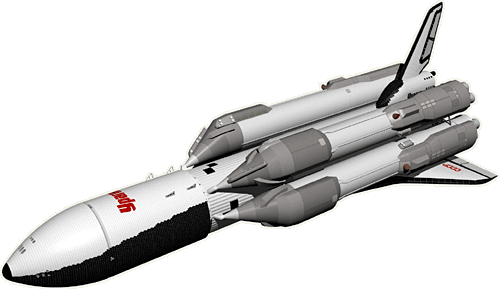
Spacecraft, length of almost 37 m and a diameter of 4 to 1 m, weighed about 80 tons and consisted of two main modules: a functional-unit service (FSB) and a larger target module (CM). FSB was an only slightly modified for this new challenge, the 20-ton ship, developed for the station "Mir". It housed the control system, telemetry, power supply and antenna systems. All devices and systems which can not withstand the vacuum placed in a sealed instrument-cargo compartment (PGO). In propulsion compartment housed four boosters, 20 engines orientation and stabilization, and 16 engines accurate stabilization, as well as fuel tanks. Placed on the sides of the solar panels, pull-down after reaching orbit. A major new fairing, which protects the unit from the incoming air flow was first made of carbon fiber. The entire apparatus was painted with black paint for the desired thermal regime.
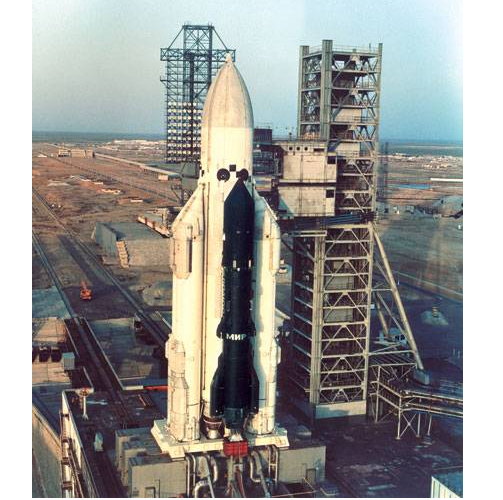
Instrument of the main fire
The central part of the "Scythian" was unsealed design, and place it where the most important load - a prototype of a gas-dynamic laser. Of all the different design of the laser was chosen gasdynamic working on carbon dioxide (CO2). Although these lasers are small and efficiency (about 10%), but they differ in simple design and well developed. NGOs engaged in the development of the laser with the space called "Astrophysics". A special device - laser pumping system - Develop KB, occupies rocket engines. This is not surprising: the pumping system is a conventional liquid rocket engine. To expiring gases when firing does not rotate station, she was wearing a special device the membrane exhaust, or as it was called by its developers, "trousers". A similar system was applied to block electromagnetic gun where the gas path had to work for the exhaust turbine generator.
(According to some sources, the laser is not planned on carbon dioxide, and halogens - the so-called excimer laser. According to official data, "Skif" was equipped with cylinders with a mixture of xenon and krypton. If there add, for example, fluorine or chlorine, you get the basics excimer laser (mixture argonftor, kriptonhlor, kriptonftor, ksenonhlor, ksenonftor))
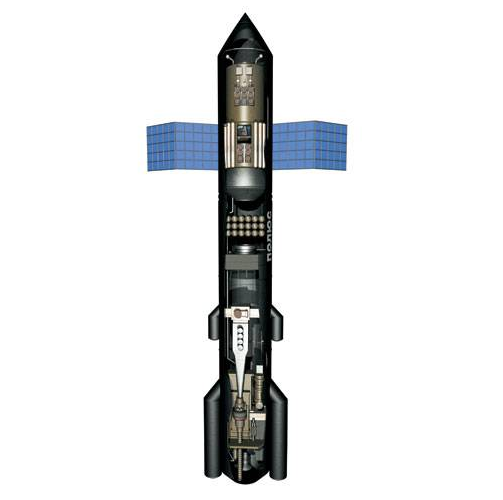
Fake ship
The first launch of "Energy", "Skiff" did not have time, so it was decided to run a mock battle station, what they talked about the letters "DM" in its title - a dynamic layout. Executable module contains only the most basic components and partial supply of the working fluid - CO2. The optical system of the laser on the first start was not, as her delivery was late. Were on board and special target, which was planned to shoot from the station in space and check on them guidance system.
In February 1987, "Skif-DM" arrived for docking with the "energy" in the technical position. On board the "Skif-DM" in large letters on a black surface has been written it a new name - "Pole" and the other was derived "Mir-2", although nothing to do with peaceful space station "Mir", he did not. By April, the station was ready to start. The launch took place May 15, 1987. It should be noted that the station was attached to raketenositelyu backwards - so demanded features of its design. After separation she had to turn around on its own engines 1800 and the desired speed dial to enter the orbit. Because of errors in the software station, turning to 1800 continued rotation of the motors worked in the wrong direction and instead of going into orbit, "Skif" returned to Earth.
TASS news about the first start of "Energy" states: "The second stage of the launch vehicle brought to the calculated point dimensions and weight mock satellite ... However, because of abnormal operation of its systems on board layout into the desired orbit did not come out and splashed down in the Pacific Ocean." So drowned unrealized military space plans of the Soviet Union, but so far, no one country can not even come close to the now almost mythical "Skif».

Development of laser battle stations "Skif", intended to destroy low-orbit space analyzing processes airborne laser system began in NGOs "Energy", but due to the large NGOs zagruzzhennostyu 1981 theme "Skif" to create a laser battle stations transmit in the OKB-23 ( CB "Salute") (CEO Poluhin DA). This spacecraft with laser onboard complex, which was created in the NGO "Astrophysics", had a length of approx. 40 m and weight 95 tons. To launch the spacecraft "Skif" suggested the use of "Energia».
August 18, 1983 General Secretary of the CPSU Y. Andropov made a statement that the Soviet Union unilaterally terminate the test set FFP - then all the tests were discontinued. However, with the advent of MS Gorbachev and the announcement of the US SDI program of work on space defense continued. To test the laser battle stations was designed dynamic analog of "Skif-D", approx. 25 m and 4 m in diameter, outside to outside of it was similar future battle station. "Skif-D" was made of steel plate, internal bulkheads complement and gained weight. Inside, the layout - emptiness. For the mission he had to splash down with the second stage of the "Energy" in the Pacific Ocean.
In the future, for the test run "Energia" in a matter of urgency was created breadboard station "Skif-DM" ("Pole") length of 37 m, a diameter of 4, 1 m and weighing 80 tons.
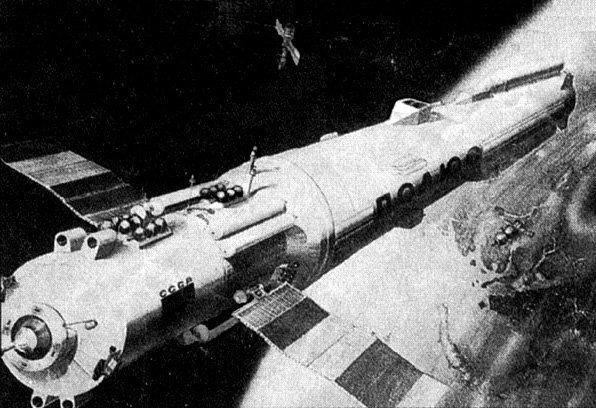
Spacecraft "Pole" was conceived in July 1985. exactly as dimensions and weight layout (ORM), which was to make the first start-up "energy." This idea arose after it became clear that the main burden missiles - orbital ship "Buran" - will not be ready by that date. Initially, the task is not particularly difficult - in fact make 100-ton "pig" is not difficult. But suddenly CB "Salute" received orders to wish-Minister General Engineering: turning "blanks" in the spacecraft for geophysical experiments in near-Earth space and combine thereby testing the "energy" and 100-ton spacecraft.
As is the custom of our space industry practice new spacecraft are usually designed, tested and manufactured for at least five years. But now had to find a new approach. Decided to actively use the most ready compartments, instruments, equipment, already tested mechanisms and assemblies, drawings with other "products».
Machine-Building Plant. Khrunichev, which was assigned to build the "pole", immediately began preparations for production. But this effort is clearly not enough, they did not support the energetic actions of management - every Thursday at the plant were operational meetings held O.D.Baklanovym Minister or his deputy O.N.Shishkinym. RAM on these "ramming"-track or something dissenting leaders allied enterprises and discussed, if required, the necessary assistance.
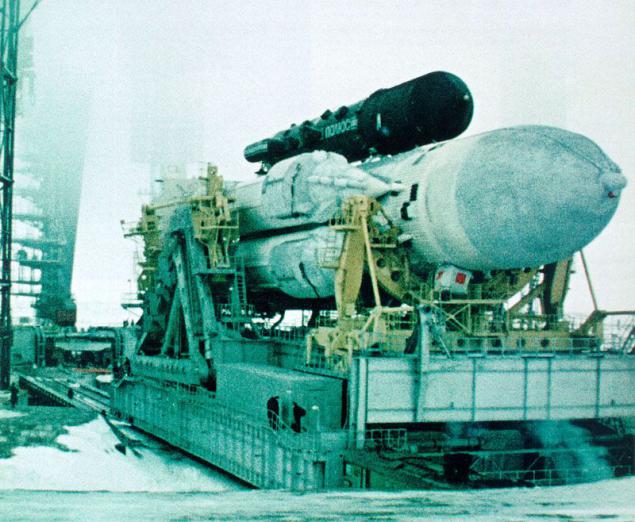
No reason, and even the fact that almost the same composition was conducted at the same time implementing an ambitious work to create "Buran", usually not taken into account. Everything was subordinated to given deadlines on top - a vivid example on command and leadership, "strong-willed" idea "willful" version of this idea, "strong-willed" time and - "money to spare!»
In July 1986 all compartments, including the re-designed and manufactured, has been at Baikonur.
May 15, 1987 from the Baikonur Cosmodrome launched the first super-heavy launch vehicle 11K25 "Energy" ╧6SL (poster-year-old). Running has become a sensation for the world space. The appearance of the carrier of this class opened up exciting prospects for our country. In his first flight booster "Energy" carried as payload experimental apparatus "Skif-DM" in the press called "Pole».
Initially start of the "Energy" - "Skif-DM" was planned for September 1986. However, due to delay production of the device, prepare the launcher and other systems work spaceport delayed by almost six months - on May 15, 1987. Only at the end of January 1987 the unit was transferred from the Assembly and Testing Facility at the 92nd floor of the cosmodrome, where he was trained in the building installation and filling complex 11P593 at the site 112A. There are 3 February 1987 "Skif-DM" was docked with the launch vehicle 11K25 "Energy" 6SL. The next day, the complex was taken to a universal comprehensive stand-start (UKSS) 17P31 250 site. There began a joint-launch tests. Continued UKSS finishing touch.
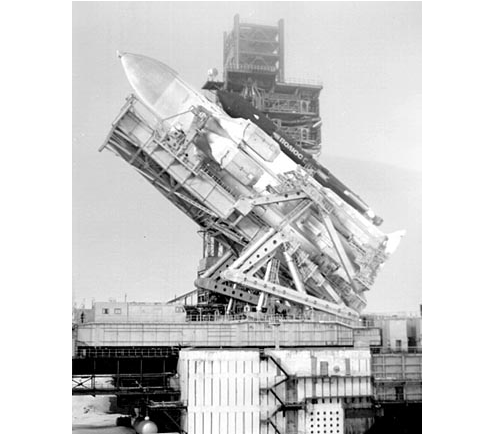
Really complex "Energy-Skif-DM" was ready to run until the end of April. All this time since early February with a rocket apparatus stood on the starting device. "Skif-DM" was fully fueled, inflated with compressed gases and equipment on-board power sources. During these three and a half months he had to undergo the most extreme climatic conditions: temperature from -27 to +30 degrees, blizzard, sleet, rain, fog and dust storms.
However, the unit survived. After extensive training start was scheduled for May 12th. The first launch of the new system with advanced spacecraft Soviet leadership seemed so important that it was going to honor his presence itself CPSU General Secretary Mikhail Gorbachev. Especially the new leader of the USSR, who took the first post in the country a year ago, has long planned to visit the main spaceport. However, even before the arrival of Gorbachev leadership training start decided not to tempt fate and insure against "the general's effect" (there is a property in any technique to break down in the presence of "high" guests). Therefore, on May 8 at a meeting of the State Commission launch complex "Energy-Skif-DM" was moved to May 15th. Gorbachev decided to say about technical problems. Wait for the same three days at the Baikonur Secretary General could not: May 15, he had already planned a trip to New York to address the United Nations.
May 11, 1987 Gorbachev arrived at the Baikonur Cosmodrome. May 12, he became acquainted with samples of space technology. The main point of the trip was Gorbachev's spaceport inspection "energy" with "Skif-DM." Then Gorbachev addressed the upcoming launch.
May 13 Gorbachev departed from Baikonur, and preparations for the launch entered its final stage.
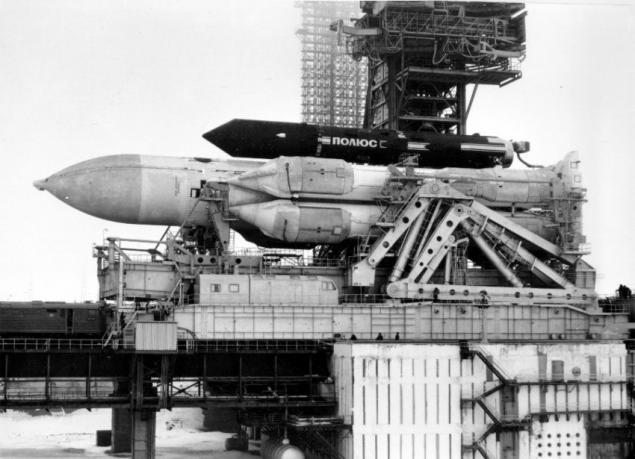
Buran orbital bomber. Space Sword USSR. Project. USSR. 70-80g.
In 1976. issued a special secret decree of the CPSU and the USSR Council of Ministers "On the investigation of the possibility of creating weapons for fighting in space and from space»
Work on space strike weapons were launched in NGOs "Energy", headed by Valentin Petrovich Glushko.
At the end of 70g. beginning 80godov NGOs "Energy" was a complex of research to identify possible ways to create space means capable of solving the problem of CA lesion military, ballistic missiles in flight, as well as critical air, sea and ground targets. The objective is to achieve the required performance of these funds on the basis of the use of the then available technological advance with the prospect of the development of these funds when capacity constraints and funding.
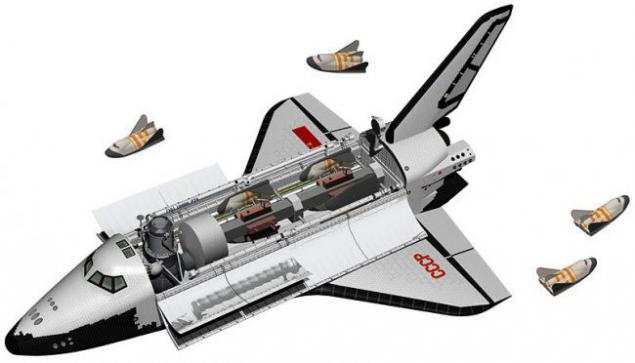
To destroy critical ground targets on the basis of KKMI "Buran" was developed orbital bomber "Buran-B". Fuselage "Buran" is used in this project as a vehicle orbital bomber: large stocks of fuel in the combined propulsion system and a very good management system enables actively maneuver in orbit, with a payload - warheads are in the cargo bay, hidden from prying eyes, and the same disadvantages of open space. Alternatively combat unit was considered the unit on the basis of already tried and tested orbital plane of the family "BOR", aka "Lapot" (project "Spiral" 1966). Another option is the screened arms ballistic nuclear warheads.
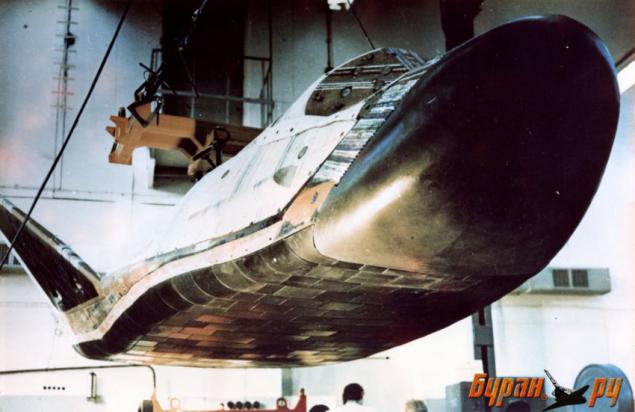
BOR warheads represent a manned or remotely controlled orbital plane armed with nuclear or other ammunition. The fuselage was made under the scheme supporting frame with very blunt feathered triangular shape in plan, because of which earned him the nickname "Lapot." Heat protection was performed using clad plates, in this case niobium based coated molybdenum disilicide. The surface temperature of the forward fuselage at different stages of descent from orbit could reach 1600 ° C. The propulsion system consisted of a liquid rocket engine (LRE) orbital maneuvering, two emergency brake LRE with pressure system components supply compressed helium, the orientation unit, consisting of 6 engines rough orientation and 10 engines precise orientation. Turbojet engine to fly at subsonic speeds and landing runs on kerosene. Modifications: photographic and radiorazvedchik, stroke to hit aircraft carriers and other ground targets, armed with a missile with a nuclear warhead and guidance system with satellite interceptors cosmic purposes.

They were placed in a compact payload bay martial percussion module with folded wing panels installed in series revolving catapult launchers.
Dimensions of the cargo hold "Buran" allows you to put on each rotating catapult install up to five warheads, as shown in the figure. Given the possible side-maneuver each combat unit during the descent in the atmosphere of not less than plus / minus 1100 - 1500 km one stroke module "Buran" could in a short time, their 10-20 maneuverable warheads "BOR", delete all life from the face of the Earth a bandwidth of up to 3000 km.
Planned two uses of "Buran-B." Solitary patrolling the Earth's orbit to the return and the simultaneous launch of the next-duty ship. And a permanent, independent duty to orbit of ships in the battle space station.
Battle Space Station, which is based on the space station series 17K DOS ("World"), which were based stand-alone modules "Buran-B" with ballistic warheads or plan type.

Combat space station consisted of the inhabited base unit on the orbital station "Mir", the control center warheads, modules battle station with sighting systems and weapon stations (based on the fuselage OK "Buran"). Supply and change of duty crews had provided transport ship "Progres", "Dawn" or manned KKMI "Buran".
That is to say, "the orbital aircraft carrier." Alarm "Buran" separate and apart at the battle of the orbit, through self-maneuvering they had to hold the desired position in space followed by separation of the blocks on the team for combat use by specified targets on Earth.
Which is especially important in the context of strategic deterrence - this weapon system could apply a sighting, "surgical" strike, even if he will be destroyed by the Soviet Union. As nuclear submarines, it can ride out the first volley and retaliate retaliation.
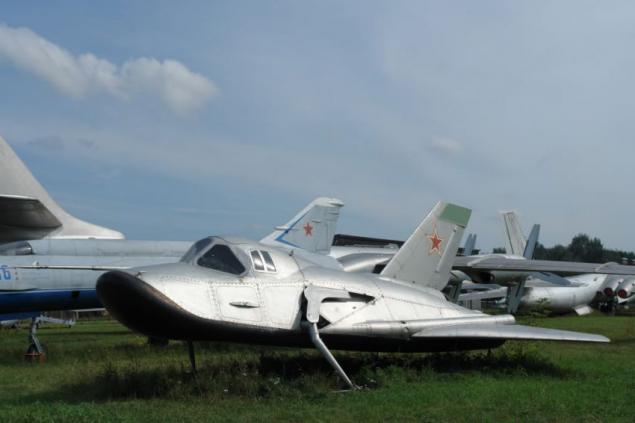
There are also reports of other military aspects of the application orbiters. In particular, under the "asymmetric response" American program "Star Wars" (SDI - Strategic Defense Initiative) Consider mining using "Buran" near-Earth space with the creation of an irresistible veil for the space segment of the SDI.
Unlike disposable fighters satellites IS new Soviet spacecraft were to intercept multiple targets. For them, the planned development of a variety of samples of space weapons; there were space-based lasers, missiles and "space - space", and even electromagnetic guns.
For example, the system "Cascade", projected on the basis of the base station "Mir" station, but which had not peace mission was designed to destroy missiles satellites in high orbits. For it had been established rocket "space - space", which has not had time to test. Luckier other military space station - "Skif", equipped with laser weapons program ASAT defense. In the future, it was supposed to be equipped with a laser system and to destroy nuclear warheads.

Spacecraft, length of almost 37 m and a diameter of 4 to 1 m, weighed about 80 tons and consisted of two main modules: a functional-unit service (FSB) and a larger target module (CM). FSB was an only slightly modified for this new challenge, the 20-ton ship, developed for the station "Mir". It housed the control system, telemetry, power supply and antenna systems. All devices and systems which can not withstand the vacuum placed in a sealed instrument-cargo compartment (PGO). In propulsion compartment housed four boosters, 20 engines orientation and stabilization, and 16 engines accurate stabilization, as well as fuel tanks. Placed on the sides of the solar panels, pull-down after reaching orbit. A major new fairing, which protects the unit from the incoming air flow was first made of carbon fiber. The entire apparatus was painted with black paint for the desired thermal regime.

Instrument of the main fire
The central part of the "Scythian" was unsealed design, and place it where the most important load - a prototype of a gas-dynamic laser. Of all the different design of the laser was chosen gasdynamic working on carbon dioxide (CO2). Although these lasers are small and efficiency (about 10%), but they differ in simple design and well developed. NGOs engaged in the development of the laser with the space called "Astrophysics". A special device - laser pumping system - Develop KB, occupies rocket engines. This is not surprising: the pumping system is a conventional liquid rocket engine. To expiring gases when firing does not rotate station, she was wearing a special device the membrane exhaust, or as it was called by its developers, "trousers". A similar system was applied to block electromagnetic gun where the gas path had to work for the exhaust turbine generator.
(According to some sources, the laser is not planned on carbon dioxide, and halogens - the so-called excimer laser. According to official data, "Skif" was equipped with cylinders with a mixture of xenon and krypton. If there add, for example, fluorine or chlorine, you get the basics excimer laser (mixture argonftor, kriptonhlor, kriptonftor, ksenonhlor, ksenonftor))

Fake ship
The first launch of "Energy", "Skiff" did not have time, so it was decided to run a mock battle station, what they talked about the letters "DM" in its title - a dynamic layout. Executable module contains only the most basic components and partial supply of the working fluid - CO2. The optical system of the laser on the first start was not, as her delivery was late. Were on board and special target, which was planned to shoot from the station in space and check on them guidance system.
In February 1987, "Skif-DM" arrived for docking with the "energy" in the technical position. On board the "Skif-DM" in large letters on a black surface has been written it a new name - "Pole" and the other was derived "Mir-2", although nothing to do with peaceful space station "Mir", he did not. By April, the station was ready to start. The launch took place May 15, 1987. It should be noted that the station was attached to raketenositelyu backwards - so demanded features of its design. After separation she had to turn around on its own engines 1800 and the desired speed dial to enter the orbit. Because of errors in the software station, turning to 1800 continued rotation of the motors worked in the wrong direction and instead of going into orbit, "Skif" returned to Earth.
TASS news about the first start of "Energy" states: "The second stage of the launch vehicle brought to the calculated point dimensions and weight mock satellite ... However, because of abnormal operation of its systems on board layout into the desired orbit did not come out and splashed down in the Pacific Ocean." So drowned unrealized military space plans of the Soviet Union, but so far, no one country can not even come close to the now almost mythical "Skif».

Development of laser battle stations "Skif", intended to destroy low-orbit space analyzing processes airborne laser system began in NGOs "Energy", but due to the large NGOs zagruzzhennostyu 1981 theme "Skif" to create a laser battle stations transmit in the OKB-23 ( CB "Salute") (CEO Poluhin DA). This spacecraft with laser onboard complex, which was created in the NGO "Astrophysics", had a length of approx. 40 m and weight 95 tons. To launch the spacecraft "Skif" suggested the use of "Energia».
August 18, 1983 General Secretary of the CPSU Y. Andropov made a statement that the Soviet Union unilaterally terminate the test set FFP - then all the tests were discontinued. However, with the advent of MS Gorbachev and the announcement of the US SDI program of work on space defense continued. To test the laser battle stations was designed dynamic analog of "Skif-D", approx. 25 m and 4 m in diameter, outside to outside of it was similar future battle station. "Skif-D" was made of steel plate, internal bulkheads complement and gained weight. Inside, the layout - emptiness. For the mission he had to splash down with the second stage of the "Energy" in the Pacific Ocean.
In the future, for the test run "Energia" in a matter of urgency was created breadboard station "Skif-DM" ("Pole") length of 37 m, a diameter of 4, 1 m and weighing 80 tons.

Spacecraft "Pole" was conceived in July 1985. exactly as dimensions and weight layout (ORM), which was to make the first start-up "energy." This idea arose after it became clear that the main burden missiles - orbital ship "Buran" - will not be ready by that date. Initially, the task is not particularly difficult - in fact make 100-ton "pig" is not difficult. But suddenly CB "Salute" received orders to wish-Minister General Engineering: turning "blanks" in the spacecraft for geophysical experiments in near-Earth space and combine thereby testing the "energy" and 100-ton spacecraft.
As is the custom of our space industry practice new spacecraft are usually designed, tested and manufactured for at least five years. But now had to find a new approach. Decided to actively use the most ready compartments, instruments, equipment, already tested mechanisms and assemblies, drawings with other "products».
Machine-Building Plant. Khrunichev, which was assigned to build the "pole", immediately began preparations for production. But this effort is clearly not enough, they did not support the energetic actions of management - every Thursday at the plant were operational meetings held O.D.Baklanovym Minister or his deputy O.N.Shishkinym. RAM on these "ramming"-track or something dissenting leaders allied enterprises and discussed, if required, the necessary assistance.

No reason, and even the fact that almost the same composition was conducted at the same time implementing an ambitious work to create "Buran", usually not taken into account. Everything was subordinated to given deadlines on top - a vivid example on command and leadership, "strong-willed" idea "willful" version of this idea, "strong-willed" time and - "money to spare!»
In July 1986 all compartments, including the re-designed and manufactured, has been at Baikonur.
May 15, 1987 from the Baikonur Cosmodrome launched the first super-heavy launch vehicle 11K25 "Energy" ╧6SL (poster-year-old). Running has become a sensation for the world space. The appearance of the carrier of this class opened up exciting prospects for our country. In his first flight booster "Energy" carried as payload experimental apparatus "Skif-DM" in the press called "Pole».
Initially start of the "Energy" - "Skif-DM" was planned for September 1986. However, due to delay production of the device, prepare the launcher and other systems work spaceport delayed by almost six months - on May 15, 1987. Only at the end of January 1987 the unit was transferred from the Assembly and Testing Facility at the 92nd floor of the cosmodrome, where he was trained in the building installation and filling complex 11P593 at the site 112A. There are 3 February 1987 "Skif-DM" was docked with the launch vehicle 11K25 "Energy" 6SL. The next day, the complex was taken to a universal comprehensive stand-start (UKSS) 17P31 250 site. There began a joint-launch tests. Continued UKSS finishing touch.

Really complex "Energy-Skif-DM" was ready to run until the end of April. All this time since early February with a rocket apparatus stood on the starting device. "Skif-DM" was fully fueled, inflated with compressed gases and equipment on-board power sources. During these three and a half months he had to undergo the most extreme climatic conditions: temperature from -27 to +30 degrees, blizzard, sleet, rain, fog and dust storms.
However, the unit survived. After extensive training start was scheduled for May 12th. The first launch of the new system with advanced spacecraft Soviet leadership seemed so important that it was going to honor his presence itself CPSU General Secretary Mikhail Gorbachev. Especially the new leader of the USSR, who took the first post in the country a year ago, has long planned to visit the main spaceport. However, even before the arrival of Gorbachev leadership training start decided not to tempt fate and insure against "the general's effect" (there is a property in any technique to break down in the presence of "high" guests). Therefore, on May 8 at a meeting of the State Commission launch complex "Energy-Skif-DM" was moved to May 15th. Gorbachev decided to say about technical problems. Wait for the same three days at the Baikonur Secretary General could not: May 15, he had already planned a trip to New York to address the United Nations.
May 11, 1987 Gorbachev arrived at the Baikonur Cosmodrome. May 12, he became acquainted with samples of space technology. The main point of the trip was Gorbachev's spaceport inspection "energy" with "Skif-DM." Then Gorbachev addressed the upcoming launch.
May 13 Gorbachev departed from Baikonur, and preparations for the launch entered its final stage.

Buran orbital bomber. Space Sword USSR. Project. USSR. 70-80g.
In 1976. issued a special secret decree of the CPSU and the USSR Council of Ministers "On the investigation of the possibility of creating weapons for fighting in space and from space»
Work on space strike weapons were launched in NGOs "Energy", headed by Valentin Petrovich Glushko.
At the end of 70g. beginning 80godov NGOs "Energy" was a complex of research to identify possible ways to create space means capable of solving the problem of CA lesion military, ballistic missiles in flight, as well as critical air, sea and ground targets. The objective is to achieve the required performance of these funds on the basis of the use of the then available technological advance with the prospect of the development of these funds when capacity constraints and funding.

To destroy critical ground targets on the basis of KKMI "Buran" was developed orbital bomber "Buran-B". Fuselage "Buran" is used in this project as a vehicle orbital bomber: large stocks of fuel in the combined propulsion system and a very good management system enables actively maneuver in orbit, with a payload - warheads are in the cargo bay, hidden from prying eyes, and the same disadvantages of open space. Alternatively combat unit was considered the unit on the basis of already tried and tested orbital plane of the family "BOR", aka "Lapot" (project "Spiral" 1966). Another option is the screened arms ballistic nuclear warheads.

BOR warheads represent a manned or remotely controlled orbital plane armed with nuclear or other ammunition. The fuselage was made under the scheme supporting frame with very blunt feathered triangular shape in plan, because of which earned him the nickname "Lapot." Heat protection was performed using clad plates, in this case niobium based coated molybdenum disilicide. The surface temperature of the forward fuselage at different stages of descent from orbit could reach 1600 ° C. The propulsion system consisted of a liquid rocket engine (LRE) orbital maneuvering, two emergency brake LRE with pressure system components supply compressed helium, the orientation unit, consisting of 6 engines rough orientation and 10 engines precise orientation. Turbojet engine to fly at subsonic speeds and landing runs on kerosene. Modifications: photographic and radiorazvedchik, stroke to hit aircraft carriers and other ground targets, armed with a missile with a nuclear warhead and guidance system with satellite interceptors cosmic purposes.

They were placed in a compact payload bay martial percussion module with folded wing panels installed in series revolving catapult launchers.
Dimensions of the cargo hold "Buran" allows you to put on each rotating catapult install up to five warheads, as shown in the figure. Given the possible side-maneuver each combat unit during the descent in the atmosphere of not less than plus / minus 1100 - 1500 km one stroke module "Buran" could in a short time, their 10-20 maneuverable warheads "BOR", delete all life from the face of the Earth a bandwidth of up to 3000 km.
Planned two uses of "Buran-B." Solitary patrolling the Earth's orbit to the return and the simultaneous launch of the next-duty ship. And a permanent, independent duty to orbit of ships in the battle space station.
Battle Space Station, which is based on the space station series 17K DOS ("World"), which were based stand-alone modules "Buran-B" with ballistic warheads or plan type.

Combat space station consisted of the inhabited base unit on the orbital station "Mir", the control center warheads, modules battle station with sighting systems and weapon stations (based on the fuselage OK "Buran"). Supply and change of duty crews had provided transport ship "Progres", "Dawn" or manned KKMI "Buran".
That is to say, "the orbital aircraft carrier." Alarm "Buran" separate and apart at the battle of the orbit, through self-maneuvering they had to hold the desired position in space followed by separation of the blocks on the team for combat use by specified targets on Earth.
Which is especially important in the context of strategic deterrence - this weapon system could apply a sighting, "surgical" strike, even if he will be destroyed by the Soviet Union. As nuclear submarines, it can ride out the first volley and retaliate retaliation.

There are also reports of other military aspects of the application orbiters. In particular, under the "asymmetric response" American program "Star Wars" (SDI - Strategic Defense Initiative) Consider mining using "Buran" near-Earth space with the creation of an irresistible veil for the space segment of the SDI.
Tags
See also
A brief history of space exploration,
Empire Star Sword
On the outer heat and cold
Record by definition images from space
Almost funny cosmic accident
How fast and safe can be space flight for humans?
Where lies the history of the cosmos
According to Angara 18
Soviet Space in the work of Soviet cosmonauts (38 photos)
Curse "Buran"
















